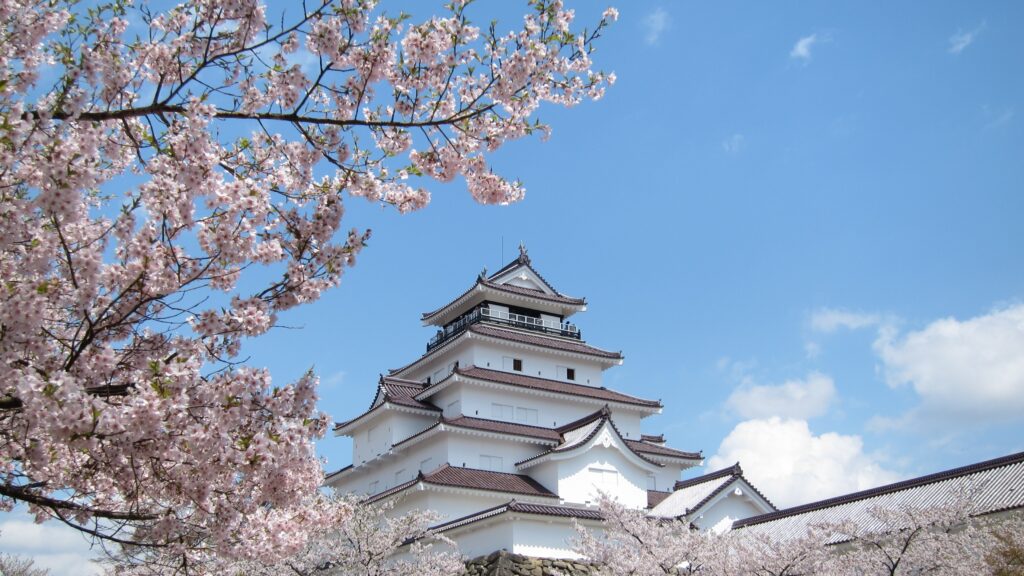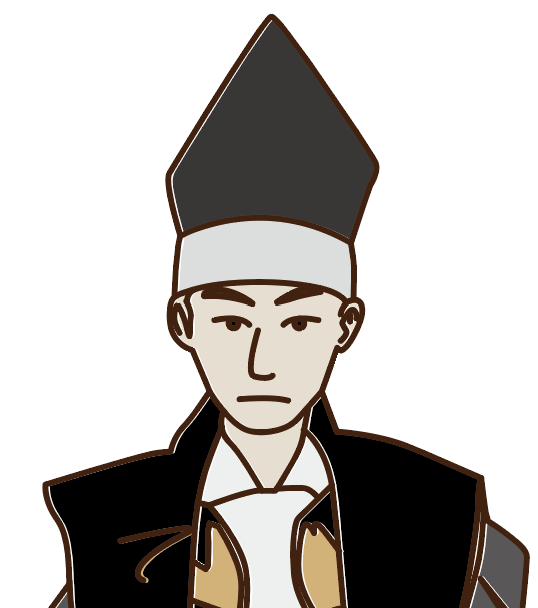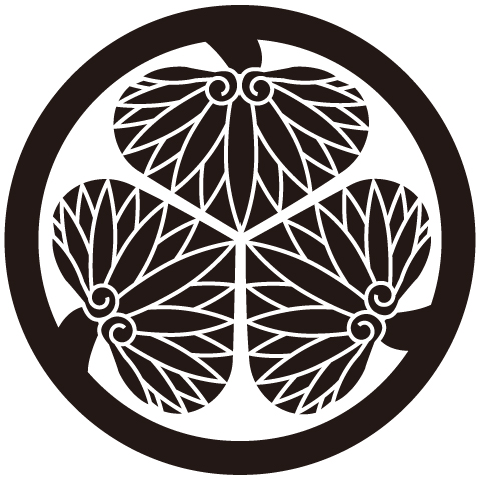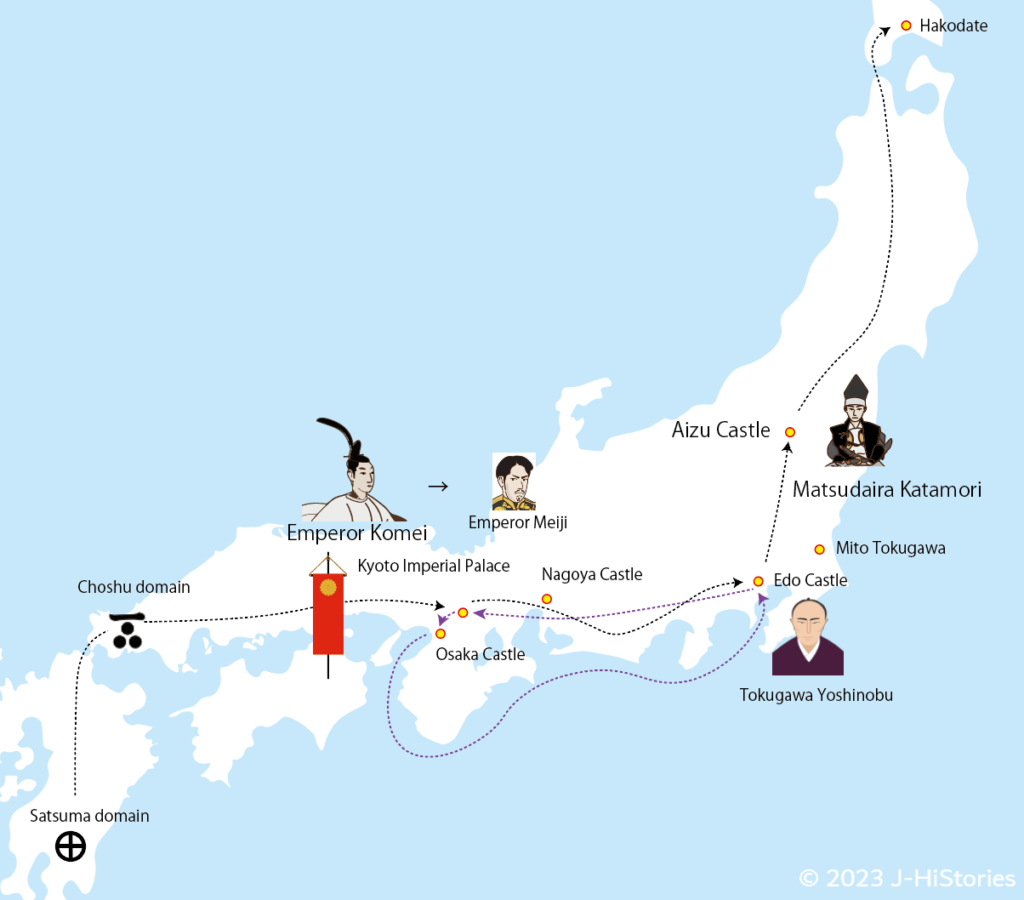Tsurugajo Castle in Aizu, A symbol of samurai loyalty during the Meiji restoration
Bells rang in the center of the castle town of the Aizu domain, signaling the invasion of Meiji government forces. Despite the Aizu domain's allegiance to the Tokugawa Shogunate and generations of shoguns, the castle fell under incessant bombardment. This is in contrast to the Shogun's residence, Edo Castle, which surrendered without bloodshed. Why did Tsurugajo Castle fall? The tragedy is said to be caused by Article 1 of Aizu's family precepts, which demanded loyalty to the Tokugawa Shogun: "Be Faithful to Tokugawa". Let's take a closer look at Aizu's history during the turmoil around the end of the Edo Period.

Bells sounded the alarm across the center of Aizu Castle town

Matsudaira Katamori (1836-1893), the feudal lord of the Aizu domain, located in Fukushima prefecture, under the Tokugawa Shogunate, surrendered to the Meiji New Government Army on September 22, 1868, after a do-or-die resistance during the siege of Tsurugajo Castle. The siege lasted a month, with the castle enduring a constant barrage of cannon fire day and night. On some days, as many as 2,500 shots were fired, with a daily average of more than 1,000 shots. The year before, in November of 1867, the last Shogun, Tokugawa Yoshinobu (1837-1913), returned sovereignty to the 122nd Emperor Meiji (1852-1912), which marked the end of the Tokugawa Shogunate and the beginning of the Meiji Restoration. Nevertheless, the Meiji government army, led by the Satsuma and Choshu domains, continued to battle to wipe out their opponents. The Aizu domain, being pro-Shogunate, was a symbolic target for defeat. Twenty young men aged 16 or 17 from the Aizu domain's military unit, Byakkotai, traveled through the Takizawa pass and Tonokuchi-Seki cave before arriving at Mt. Iimori. There, they saw Tsurugajo Castle being bombarded by cannon fire and mistakenly believed that they had been defeated. Under the extreme conditions of living without food and enduring constant rainfall, the young men were driven to commit suicide. Only one, Iinuma Sadakichi, survived, and he passed down the story of the tragic events of Byakkotai for posterity.
Be faithful to Tokugawa Shogun

The Matsudaira clan of the Aizu domain traced its origin to Hoshina Masayuki (1611-1673; 保科正之), the son of the second Shogun, Tokugawa Hidetada (1579-1632; 徳川秀忠). Masayuki's son was officially recognized by the Shogunate as a member of the Matsudaira clan and granted the right to use the Tokugawa family crest of Mitsuba-Aoi as well as the surname of Matsudaira, which was the Tokugawa's former surname. However, Aizu's strict adherence to Article 1 of their family precepts, which was to remain loyal to the Tokugawa Shogunate, ultimately led to their tragic downfall. To better understand this tragedy, we need to examine the final stage of the Edo period (1603-1868).
Open country or exclude Western powers?
Around 1850, Western powers such as France, the US, the UK, and Russia demanded trade with Japan. This led to heated arguments among the Tokugawa Shogunate, including feudal lords, especially powerful domains such as Aizu, Satsuma, Choshu, and the Imperial Court. The key opposing opinions were (a) the open country wing or anti-foreignism, (b) the overthrow of the Tokugawa Shogunate or the maintenance of the regime, and (c) Kobugattai (reconciliation between the Imperial Court and the Shogunate) or independence from the court. To overcome the national crisis, the Tokugawa Shogunate sought a wide range of opinions and suggestions, opening the right for low-ranking samurai to have a voice in political matters. Furthermore, the idea of reverence for the Emperor, known as "Sonnou", became a key opinion. These arguments eventually escalated into armed conflict, causing many pro-imperialists, including masterless samurai, to converge on Kyoto. They aimed to establish an Emperor-centric political system that was independent of foreign powers. This opinion was called "Sonnou-Joi."
Shinsengumi security force protected Kyoto from assassinations, looting, and lawlessness
In this situation, the Tokugawa Shogunate requested the Aizu domain to safeguard Kyoto and the Emperor because Aizu was one of the militarily powerful domains at that time. At first, Aizu diplomatically turned down the request because they believed it would run the risk of plunging Aizu into economic ruin due to the cost, which was calculated to be way beyond their annual expense. However, Article 1, "Be faithful to Tokugawa Shogun," stirred Katamori to take the "Kyoto Shugo-shoku" position (a position for keeping order in Kyoto) in September 1862.
The 121st Emperor Komei (1831-1867, 孝明天皇) sought to achieve "Joi" (expulsion of foreigners from Japan) through political consensus with the Tokugawa Shogunate. However, several nobles and pro-imperialists from Choshu controlled the court council and took radical steps towards realizing Joi, very violently and against Emperor Komei's intention. Eventually, Choshu attacked Western ships as part of their Joi campaign. Emperor Komei was deeply concerned about this situation and, in 1863, he exiled Choshu from Kyoto with the assistance of the forces of the Aizu and Satsuma domains.

Several months later, an incident occurred at the Ikedaya Inn in Kyoto. About 50 pro-imperialists, mainly young samurai of Choshu, were hidden there, huddled together to discuss how to realize Sonnou-Joi. The plan was extremely radical and dangerous, including setting the Kyoto Palace ablaze on a windy day, incarcerating Prince Nakagawa, assassinating Yoshinobu and Katamori, and forcing Emperor Komei to move to far-off Choshu. However, the Shinsengumi (a unified security force under the control of the Aizu Domain) got wind of the plan. At around 10 p.m. on July 8th, the Shinsengumi stormed into the Ikedaya Inn, started a fierce fight using swords in the darkness, and emerged victorious. Many Choshu samurai died from sword wounds, and some were arrested. Hijikata Toshizo, deputy chief of the Shinsengumi, was very active.
Emperor Komei gave Katamori a handwritten letter to express trust in Aizu

Choshu did not give up on their plan to regain their lost position in Kyoto. One month later, they launched a cannon attack on the Kyoto Imperial Palace, an incredible act. The imperial forces of Aizu, Satsuma, and Shinsengumi worked together to protect Emperor Komei and the court nobles by closing nine gates and repelling the Choshu attackers in front of the Hamaguri-Gomon gate of the Kyoto Imperial Palace in August of 1864 (known as the Hamaguri-Gomon incident). Emperor Komei was angered by the attack and issued an order to immediately track down the Choshu. As a result, Choshu became an enemy of the emperor. On the other hand, Emperor Komei presented Katamori with a "Shinkan" (a handwritten letter) to express his gratitude for Aizu's diligent service and his trust in Katamori. This was a very uncommon event.
The rapidly changing political situation led to the implementation of Taisei Hokan (Returning the political power of Tokugawa Shogunate to the Emperor)
After some time, however, both Choshu and Satsuma began to realize the urgent necessity of unifying Japan as one country to defend against colonization by Western powers. These two domains had witnessed the formidable power of Western countries first-hand through their conflicts with the US and the UK. The political situation was rapidly evolving. In March 1866, Choshu formed a political alliance with its former adversary Satsuma. The 14th Shogun, Iemochi, passed away during the Choshu Conquest in July 1866, and Yoshinobu became the 15th Shogun in the same month. Six months later, Emperor Komei suddenly passed away in January 1867, and Yoshinobu returned sovereignty to the Imperial Court in November of the same year.
The Imperial Army continued to march toward Aizu
However, the military power of the Tokugawa domain was strong enough to maintain control over the new collegial system. As a result, the new government side, Satsuma, resorted to subversive acts such as arson and robbery in Edo City to provoke the Shogunate side. This led to the Toba-Fushimi War in Kyoto in January 1868. In April, the Imperial standard was raised on the battlefield, resulting in the defeat of the Shogunate army. Yoshinobu then returned from the front lines of the Tokugawa forces at Osaka Castle to Edo Castle, pledging his allegiance to the Emperor. The bloodless surrender of Edo Castle followed in April, and Katamori returned to Aizu. However, several battles continued at Ueno in Edo and various other locations. Eventually, Choshu and Satsuma invaded Aizu to force Katamori's surrender. The sequence of wars reached Hakodate in Hokkaido and ended in September 1868. In Aizu, several thousand people died, and crop yields fell from 230,000 kokus to 30,000 kokus, causing great distress. In the cold winter, people were forced to move to Tonami in the northern part of the Shimokita Peninsula of Aomori prefecture without homes or crops, and many elderly people and children died of hunger. The Aizu people faced great difficulties finding employment, getting married, and so on for several generations.

Aizu domain's tragedies, why?
There are several theories as to why Aizu experienced such tragedies.
a distant member of the Imperial Family. Therefore, its resentment headed to Aizu.
One reason is their adherence to Article 1, which required loyalty to the Tokugawa Shogunate. Aizu was seen as a stronghold of the shogunate, which made them a target for Satsuma and Choshu. Even though Yoshinobu had returned political power to the emperor from a wide perspective to prevent domestic wars and colonization, Aizu remained steadfast in its loyalty to the shogunate.
Another reason for Aizu's defeat was its limited resources and intelligence. The slow modernization of its army and the continued use of harquebuses due to financial difficulties put it at a disadvantage against the more advanced weapons of Satsuma and Choshu. Additionally, their lack of intelligence about the rapidly changing political situation made it difficult to devise appropriate strategies to cope with the situation. Without cavalry to inspect the enemy's status on the battlefield, Aizu was forced onto a losing course. For instance, Aizu took several hours to prepare for the battle at the strategic Bonari-Toge Pass, which ultimately allowed the Imperial Army to break through it. It took a day to report the start of the battle, even though it was only a few hours away by horseback.
Lastly, Aizu was considered a political enemy of Choshu. The Shinsengumi, under the command of Aizu, had killed Choshu's samurai at the Ikedaya Inn incident, and Choshu had lost to Aizu and Satsuma at the Hamaguri-gomon incident. This resulted in resentment towards Aizu from Choshu, which may have contributed to their invasion of Aizu.
The restoration of honor through the marriage of Katmori’s granddaughter to Prince Yasuhito
Katamori kept Emperor Komei’s Shinkan with him at all times till he died in 1893 at the age of 59. The Shinkan expressed Emperor Komei's trust in Katamori's loyalty. In 1928, 60 years after the surrender of Tsurugajo Castle, Matsudaira Setsuko, granddaughter of Katamori married Prince Yasuhito (1902-1953; 秩父宮雍仁親王), great-grandson of Emperor Komei. Aizu people and the former samurai felt exceptionally deep emotion and exultance about her entrance into the Imperial Family, expecting their restoration of rights. Here, Aizu’s fundamental disgrace of the Imperial enemy was wiped out, despite Aizu being an enthusiastic imperialist and receiving Shinkan from Emperor Komei.
Be Faithful to Tokugawa and be Loyal to the Emperor.
Thinking about the history and daring spirit of Aizu, please enjoy walking in and around Aizu Wakamatsu City and Tsurugajo Castle. The mottos "Be faithful to Tokugawa Shogun" and "Be loyal to Emperor" are believed to have played a role in Aizu's tragic fate.
Matsudaira Katamori Timeline
| 1603 | Ieyasu estabished Tokugawa Shogunate at Edo | - | Edo period |
| 1643 | Hoshina Masayuki became the lord of Aizu domain | - | |
| 1836 | Mmatsudaira Katamori was born | Age=1 | |
| 1852 | Mmatsudaira Katamori became the lord of Aizu domain | 16 | |
| 1854/3 | The Treaty of Peace and Amity between the US and Japan was concluded | 18 | |
| 1862 | Yoshinobu became the guardian of the Shogun, Iemoch | 26 | |
| 1862 | Katamori became Kyoto Shogo-shoku | 26 | |
| 1864/07 | Ikedaya Inn incident | 28 | |
| 1864/08 | Kinmon incident, Yoshinobu fought and protected the Kyoto Palace | 28 | |
| 1867/01 | Tokugawa Yoshinobu was appointed the 15th Shogun | 31 | |
| 1867/01 | Emperor Komei passed away | 31 | |
| 1867/11/10 | Taisei Hokan, Tokugawa's political power was officially returned to the Emperor | 31 | |
| 1868/1/3 | The Boshin War started at Toba-Fushimi | 32 | |
| 1868/1/6 | Yoshinobu escaped from Osaka castle to Edo castle with Katamori | 32 | |
| 1868/4/11 | Edo castle surrendered without bloodshed to Imperial Army | 32 | |
| 1868/10 | The Meiji Restoration | 32 | |
| 1868/11/23 | Aizu war ended | 32 | Meiji Era |
| 1869/5 | Boshin War ended at Hakodate | 32 | |
| 1893 | Katamori passed away | 57 |
Recommendations to visit
- Access: 90 minutes from Tokyo Station to Koriyama Station by Tohoku Shinkansen. Then change trains to the Banestu-saisen line (磐越西線) bound for Aizu-Wakamatsu (会津若松). 60 minutes from Koriyama to Aizu-wakamatsu station. Take the loop bus at #4 and get off at Tsurugajo-Entrance (鶴ヶ城入口) or Tsurugajo-Kitaguchi (鶴ヶ城北口).


_169sakai-city-300x169.jpg)